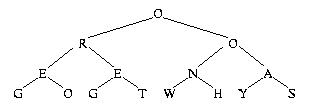COSC 387: Artificial Intelligence
Project 1
Fall 2010
Due: Wed, Sep 29 @ 10 P.M.
4 points
- Write a function that uses the do form to find the minimum
and maximum values in a list of numbers. The function should return
these two values in a list. Do not use the min and max
functions in your implementation.
- Same problem as above, but use recursion.
- Same problem as above, but use apply,
min, and max.
- Encode the following tree as a list assigned to a globally
declared variable. Write two Lisp functions, preorder and postorder,
that returns as a list the pre-order and post-order traversals of the tree
passed in as the argument, respectively.

For example,
> (preorder *tree*)
(O R E G O ... )
- Encode the following graph using property lists. Write a Lisp
function that, when given a start and an end node, uses depth-first
search to return a path between them.

For example,
>(dfs 'a 'g)
(A C F E G)
>(dfs 'f 'g)
(F E G)
>(dfs 'e 'c)
NIL
- Develop a representation for a tic-tac-toe board. Write a
function that, when given a board configuration as its argument,
returns a list containing all of the next possible moves.
- Tanimoto defined a heuristic evaluation function for tic-tac-toe
boards as
f = 100A + 10B + C - (100D + 10E + F),
where
- A is the number of lines with 3 X's,
- B is the number of unblocked lines w/ 2 X's,
- C is the number of unblocked lines with 1 X,
- D is the number of lines with 3 O's,
- E is the number of unblocked lines w/ 2 O's, and
- F is the number of unblocked lines w/ 1 O.
Implement Tanimoto's heuristic evaluation function. That is, when
given a tic-tac-toe board configuration, the function returns f.
Extra Credit (1 point each)
- Conduct a timing study using your three implementations of
the “min-max” function (items 1–3 above).
Write a function that
returns a list of 1000 random numbers. Write another function that
generates 1000 such lists, giving each to the three implementations
of the min-max function. Use the time function to determine
how much time each implementation requires to process the 1000 lists.
Which is faster? Why?
- There are two possible ways to iterate through a list.
One can use dolist or one can use dotimes,
length, and nth. Using the functions above,
iterate through 1000 lists of 1000 random numbers using both
of these methods and time them. Which is faster? Why?
Instructions for Electronic Submission
In the header comments of the primary file, provide the following information:
;;;;
;;;; Name
;;;; E-mail Address
;;;; Platform: Windows, Linux (seva), etc.
;;;; Lisp Environment: clisp, gcl, cmucl
;;;;
;;;; In accordance with the class policies and Georgetown's Honor Code,
;;;; I certify that, with the exceptions of the course materials and those
;;;; items noted below, I have neither given nor received any assistance
;;;; on this project.
;;;;
You'll be using Blackboard to
submit your assignments. Put everything in a zip file and upload it.
You must submit your project before 10 PM on the due date.
Plan B
If something goes wrong with Blackboard, then send your project as an
attachment to an e-mail to me.
Copyright © 2019 Mark Maloof. All Rights Reserved.
This material may not be published, broadcast, rewritten,
or redistributed.

